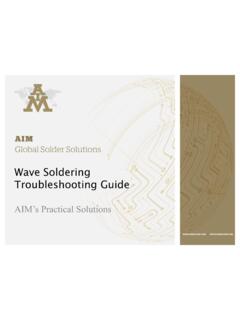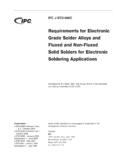Transcription of Soldering Guidelines - University of Alberta
1 Soldering Guidelines Solder0 EE400/1. Design Revision History Rev. Date Contributor September 2005 L. Wyard-Scott Updates to reflect changed Capstone Design Course for- mat and new de/ Soldering equipment. January 2004 Sieben, L. Wyard- Creation. Scott, E. Tiong Contents 1 Soldering Technique 1. Required Tools .. 1. Important Soldering Tips .. 2. Precautions .. 3. How to Solder Through-Hole Components .. 4. How to Solder Surface-Mount Components .. 8. Wire Connectors and Headers .. 9. Crimp Connectors and Pins .. 9. DB Connectors (Solder Cup Type) .. 10. Joining Two Wires .. 10. Testing Connections .. 11. Milled Board Soldering .. 12. Post- Soldering Cleanup.
2 12. PCB Cleanup .. 12. Work Area Cleanup .. 12. 2 Desoldering Technique 13. Solder Pump/Sucker .. 13. Desoldering Braid/Wick .. 14. Desoldering Iron .. 15. Removing Components Effectively .. 16. 3 Glossary 17. Bibliography 18. A Pictures of Tools 19. i Chapter 1. Soldering Technique This guide is intended to give an introduction to basic Soldering technique. If the reader desires to pursue advanced Soldering techniques, there are several books as well as technical institutions that offer detailed courses in the area of Soldering . Required Tools Before discussing Soldering techniques, one should must set up a Soldering work station . The following is a list of tools for a typical Soldering station.
3 See Appendix A for pictures of the various parts listed below. 1. Variable temperature Soldering iron: used for applying heat to joints during the Soldering process. 2. Damp sponge: for cleaning Soldering iron tip. 3. Rosin-core solder: to electrically and mechanically bond a compo- nent to the PCB. 4. Wire cutters or side cutter: for trimming component leads and stripping insulation from wires. 5. Needle nose pliers: for holding, placing and shaping components. 6. Desoldering pump and/or desoldering braid: for removing sol- der. 7. Scotch tape and/or a Third Hand : for securing components. 1. Soldering Guidelines (Solder0) Revision Important Soldering Tips 2.
4 8. Safety glasses: for eye protection. These are mandatory in the lab. 9. Magnifier: to provide more detail during intricate work. A magnify- ing glass is convenient, but an illuminated magnifier is better. 10. Light source: to prevent eye-strain. 11. Ventilation: to extract and dispel fumes generated during the sol- dering process. 12. Flux: to clean components and PCB pads. 13. Acid brush: to assist in the removal of flux residue. Prior to Soldering it is a good idea to have all components organized as it will make populating the PCB more efficient. Make a BOM (bill of materials) for the PCB, and ensure before Soldering that the components have been collected.
5 The schematic and PCB layout will also be referred to when populating the board. Important Soldering Tips The following tips provide a quick guideline on how to make proper joints. Cleanliness: All parts, including the Soldering iron tip, must be clean and free from grease, oxidation and contamination. Solder does not flow over contaminated areas; moreover, solder is repelled by dirt. Severe contamination is evident when solder begins to bead . A common source of contamination is oxidation. Old components and copper boards will often have an oxide layer that prevents a good solder joint. Ensure all components have shiny leads and the PCB has clean traces.
6 An abrasive such as a blue or pink eraser, emery paper, or stell wool can be used to remove the oxidized layer from the PCB board and components. Tinning: In addition to being clean, the Soldering iron tip must also be tinned (coated with solder). Tinning the tip allows solder to flow on the components more quickly rather than the Soldering iron tip itself. Tinning involves adding a few millimetres of solder to the tip and then wiping and rotating the tip on the damp sponge to reveal a shiny surface on the tip of the Soldering iron: a thin layer of solder will coat or tin the tip of the Soldering iron. When done Soldering , Soldering Guidelines (Solder0) Revision Precautions 3.
7 Tinning the iron is required to protect the tip from oxidation thereby dramatically increasing its life. Temperature: Ensure that both the component leads and the PCB's cop- per layer are heated at the same time. The Soldering iron tip should contact both the component and the PCB pad. This will ensure that each surface is relatively close in temperature resulting in a good joint. If there is a temperature difference between the two surfaces, the sol- der will form a dry joint. Soldering irons are typically set around 650 Fahrenheit, depending on the lead-tin ratio of the solder being used. Too much heat causes excessive sputtering of flux, and too little doesn't melt the solder in a timely manner.
8 Duration: The duration that the iron is in contact with the component and PCB is dependent on the size of the joint and your Soldering iron temperature. For the typical PCB through-hole joint, it should take a few seconds to heat the joint and apply the solder. This will require practice, so don't expect to be fast if you are a beginner. Excessive heat (several seconds in duration) will damage sensitive semiconductors. If this is a concern, use a heat sink attached to the component leads: sometimes as simple as an alligator clip. These concerns can sometimes be avoided by Soldering sockets instead of the semiconductor itself. Adequate solder coverage: If too little solder is applied, the joint will not make a secure connection and will cause erratic behaviour.
9 How- ever, if too much solder is applied, the joint may bridge with adjacent joints resulting in electrical shorts. How much solder to apply comes with experience. Figs. through show good and bad solder joints. Handling: Most modern electronics systems contain static-sensitive de- vices. Use proper handling procedures to minimize the likelihood of damage: grounding wrist-straps, grounded Soldering irons, grounding mats, etc. Precautions Soldering Irons get very hot (600-800 0 F, 315-4250 C), please ensure you fol- low precautions during use. Basic safety precautions are listed below. Never leave your iron turned on while unattended. Soldering Guidelines (Solder0) Revision How to Solder Through-Hole Components 4.
10 Turn the Soldering iron off when it is not being used. If the iron is left on for long periods of idle time, the Soldering iron tip will be destroyed through oxidation. Eye protection must always be worn when Soldering . Hot flux can spit up and into an unprotected eye. In the Capstone Design Lab, use of eye protection is mandatory. If the cord of the Soldering iron is damaged, inform the lab staff who will ensure it is replaced. Never set the Soldering iron down on anything other than an iron stand. To prevent burning your fingers, use needle nose pliers, heat resistant gloves, or a third hand tool to hold small pieces. Familiarize yourself with the safe handling of all materials used during the Soldering process.









